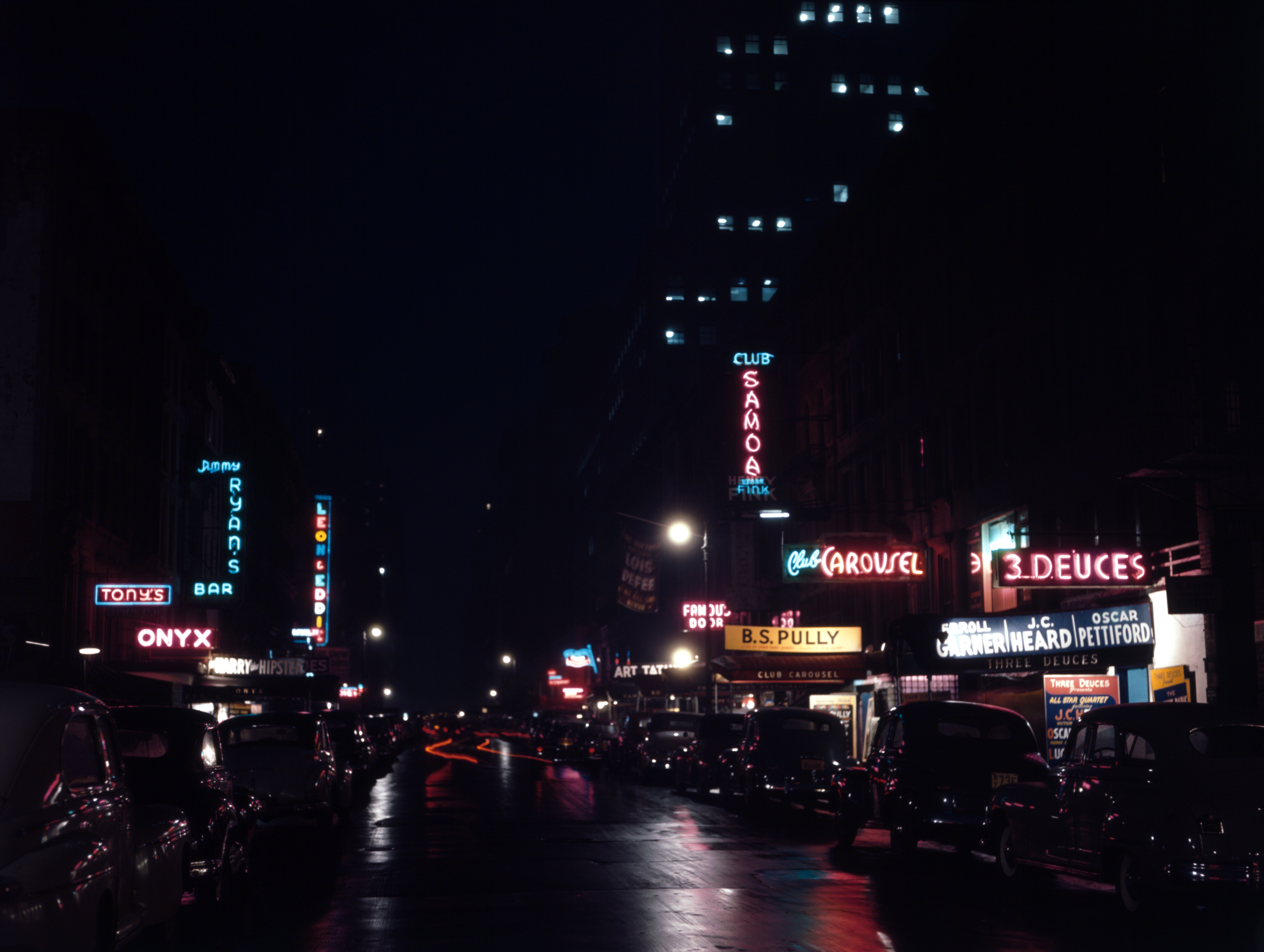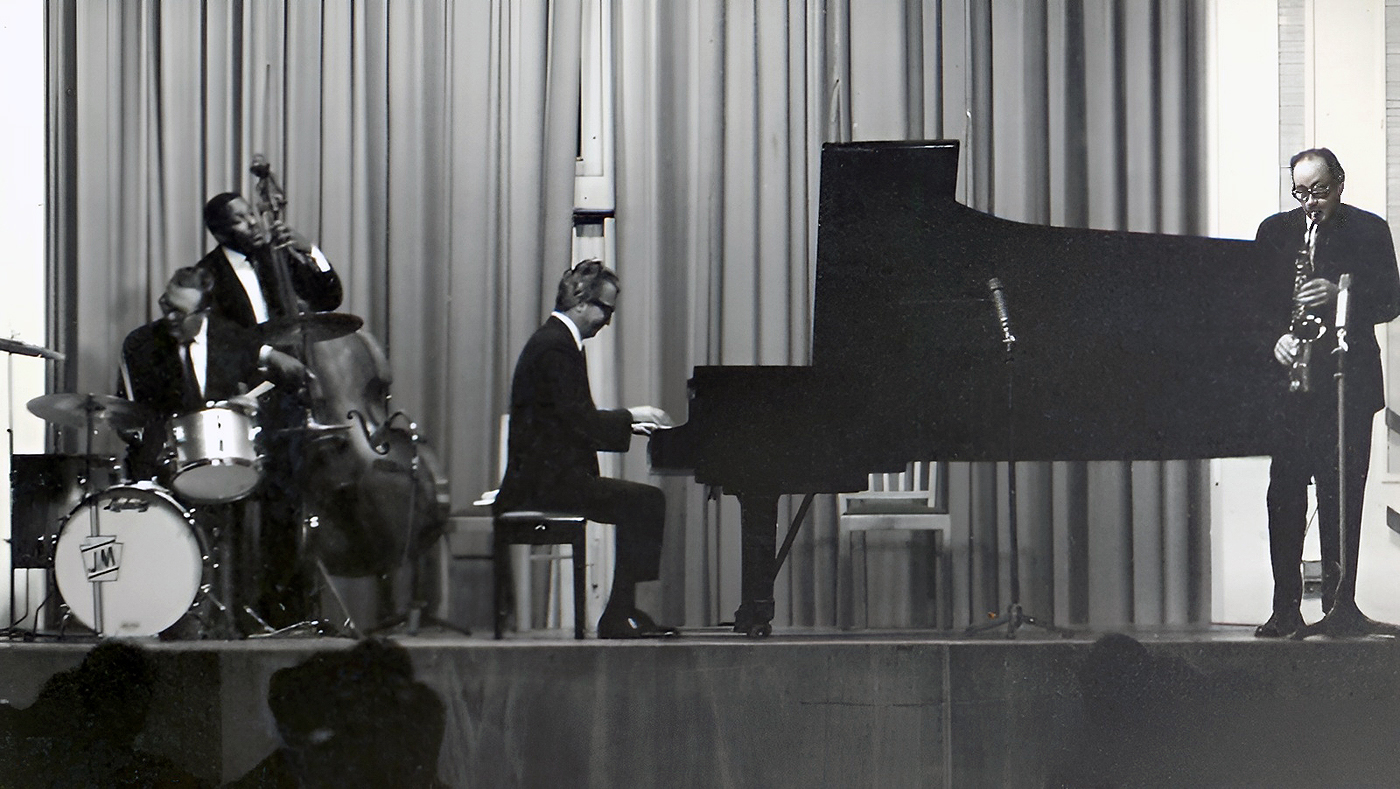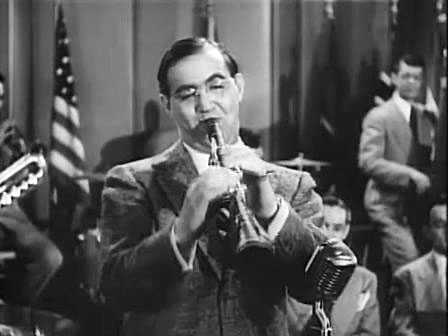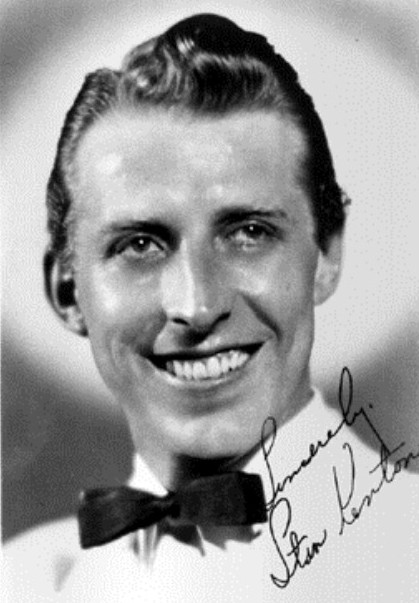|
Cool Jazz
Cool jazz is a style of modern jazz music that arose in the United States after World War II. It is characterized by relaxed tempos and lighter tone, in contrast to the fast and complex bebop style. Cool jazz often employs formal arrangements and incorporates elements of classical music. Broadly, the genre refers to a number of post-war jazz styles employing a more subdued approach than that found in other contemporaneous jazz idioms. As Paul Tanner, Maurice Gerow, and David Megill suggest, "the tonal sonorities of these conservative players could be compared to pastel colors, while the solos of izzy Gillespie and his followers could be compared to fiery red colors." The term ''cool'' started being applied to this music around 1953, when Capitol Records released the album ''Classics in Jazz: Cool and Quiet''. Mark C. Gridley, writing in the ''All Music Guide to Jazz'', identifies four overlapping sub-categories of cool jazz: # "Soft variants of bebop," including the Miles Dav ... [...More Info...] [...Related Items...] OR: [Wikipedia] [Google] [Baidu] |
Bebop
Bebop or bop is a style of jazz developed in the early-to-mid-1940s in the United States. The style features compositions characterized by a fast tempo, complex chord progressions with rapid chord changes and numerous changes of key, instrumental virtuosity, and improvisation based on a combination of harmonic structure, the use of scales and occasional references to the melody. Bebop developed as the younger generation of jazz musicians expanded the creative possibilities of jazz beyond the popular, dance-oriented swing music-style with a new "musician's music" that was not as danceable and demanded close listening.Lott, Eric. Double V, Double-Time: Bebop's Politics of Style. Callaloo, No. 36 (Summer, 1988), pp. 597–605 As bebop was not intended for dancing, it enabled the musicians to play at faster tempos. Bebop musicians explored advanced harmonies, complex syncopation, altered chords, extended chords, chord substitutions, asymmetrical phrasing, and intricate melodi ... [...More Info...] [...Related Items...] OR: [Wikipedia] [Google] [Baidu] |
Birth Of The Cool
''Birth of the Cool'' is a compilation album by American jazz trumpeter and bandleader Miles Davis, released in February 1957 by Capitol Records. It compiles eleven tracks recorded by Davis's nonet for the label over the course of three sessions during 1949 and 1950. Featuring unusual instrumentation and several notable musicians, the music consisted of innovative arrangements influenced by classical music techniques such as polyphony, and marked a major development in post-bebop jazz. As the title suggests, these recordings are considered seminal in the history of cool jazz. Most of them were originally released in the 10-inch 78-rpm format and are all approximately three minutes long. Background From 1944 to 1948, Miles Davis played in Charlie Parker's quintet. Davis recorded several albums worth of material with Parker during this period, including Parker's Sessions for the Savoy and Dial labels. Davis' first records released under his own name were recorded with Parker' ... [...More Info...] [...Related Items...] OR: [Wikipedia] [Google] [Baidu] |
Paul Desmond
Paul Desmond (born Paul Emil Breitenfeld; November 25, 1924 – May 30, 1977) was an American jazz alto saxophone, alto saxophonist and composer, best known for his work with the Dave Brubeck Quartet and for composing that group's biggest hit, "Take Five". He was one of the most popular musicians to come out of the cool jazz scene. In addition to his work with Brubeck, he led several groups and collaborated with Gerry Mulligan, Chet Baker, Jim Hall (musician), Jim Hall, and Ed Bickert. After years of chain smoking and poor health, Desmond succumbed to lung cancer in 1977 after a tour with Brubeck. Early life Desmond was born Paul Emil Breitenfeld in San Francisco, California, in 1924, the son of Shirley (née King) and Emil Aron Breitenfeld. His grandfather Sigmund Breitenfeld was, according to an obituary, born in Austria in 1857. Sigmund Breitenfeld, a medical doctor, emigrated to New York City with his wife Hermine (born Hermine Lewy) at the end of the 19th century, and the B ... [...More Info...] [...Related Items...] OR: [Wikipedia] [Google] [Baidu] |
Dave Brubeck
David Warren Brubeck (; December 6, 1920 – December 5, 2012) was an American jazz pianist and composer. Often regarded as a foremost exponent of cool jazz, Brubeck's work is characterized by unusual time signatures and superimposing contrasting rhythms, Metre (music), meters, and tonality, tonalities. Born in Concord, California, Brubeck was drafted into the US Army, but was spared from combat service when a International Red Cross and Red Crescent Movement, Red Cross show he had played at became a hit. Within the US Army, Brubeck formed one of the first racial integration, racially diverse bands. In 1951, Brubeck formed the Dave Brubeck Quartet, which kept its name despite shifting personnel. The most successful—and prolific—lineup of the quartet was the one between 1958 and 1968. This lineup, in addition to Brubeck, featured saxophonist Paul Desmond, bassist Eugene Wright and drummer Joe Morello. A U.S. Department of State-sponsored tour in 1958 featuring the band inspir ... [...More Info...] [...Related Items...] OR: [Wikipedia] [Google] [Baidu] |
Warne Marsh
Warne Marion Marsh (October 26, 1927 – December 18, 1987) was an American tenor saxophonist. Born in Los Angeles, his playing first came to prominence in the 1950s as a protégé of pianist Lennie Tristano and earned attention in the 1970s as a member of Supersax. Biography Marsh came from an affluent artistic background: his father was Hollywood cinematographer Oliver T. Marsh (1892–1941), and his mother Elizabeth was a violinist. He was the nephew of actresses Mae Marsh and Marguerite Marsh and film editor Frances Marsh. He was tutored by Lennie Tristano. Marsh was often recorded in the company of other Cool School musicians, and remained one of the most faithful to the Tristano philosophy of improvisation – the faith in the purity of the long line, the avoidance of licks and emotional chain-pulling, the concentration on endlessly mining the same small body of jazz standards. While Marsh was a generally cool-toned player, the critic Scott Yanow notes that Marsh played w ... [...More Info...] [...Related Items...] OR: [Wikipedia] [Google] [Baidu] |
Lee Konitz
Leon Konitz (October 13, 1927 – April 15, 2020) was an American composer and alto saxophonist. He performed successfully in a wide range of jazz styles, including bebop, cool jazz, and avant-garde jazz. Konitz's association with the cool jazz movement of the 1940s and 1950s includes participation in Miles Davis's ''Birth of the Cool'' sessions and his work with pianist Lennie Tristano. He was one of relatively few alto saxophonists of this era to retain a distinctive style, when Charlie Parker exerted a massive influence. Like other students of Tristano, Konitz improvised long, melodic lines with the rhythmic interest coming from odd accents, or odd note groupings suggestive of the imposition of one time signature over another. Other saxophonists were strongly influenced by Konitz, such as Paul Desmond and Art Pepper. He died during the COVID-19 pandemic from complications brought on by the disease. Biography Early life Konitz was born on October 13, 1927, in Chicago. He ... [...More Info...] [...Related Items...] OR: [Wikipedia] [Google] [Baidu] |
Lennie Tristano
Leonard Joseph Tristano (March 19, 1919 – November 18, 1978) was an American jazz pianist, composer, arranger, and teacher of jazz improvisation. Tristano studied for bachelor's and master's degrees in music in Chicago before moving to New York City in 1946. He played with leading bebop musicians and formed his own small bands, which soon displayed some of his early interests – contrapuntal interaction of instruments, harmonic flexibility, and rhythmic complexity. His quintet in 1949 recorded the first free group improvisations. Tristano's innovations continued in 1951, with the first overdubbed, improvised jazz recordings, and two years later, when he recorded an atonal improvised solo piano piece that was based on the development of motifs rather than on harmonies. He developed further via polyrhythms and chromaticism into the 1960s, but was infrequently recorded. Tristano started teaching music, especially improvisation, in the early 1940s, and by the mid-1950s was conc ... [...More Info...] [...Related Items...] OR: [Wikipedia] [Google] [Baidu] |
Swing Music
Swing music is a style of jazz that developed in the United States during the late 1920s and early 1930s. It became nationally popular from the mid-1930s. The name derived from its emphasis on the off-beat, or nominally weaker beat. Swing bands usually featured soloists who would improvise on the melody over the arrangement. The danceable swing style of big bands and bandleaders such as Benny Goodman was the dominant form of American popular music from 1935 to 1946, known as the swing era. The verb "to swing" is also used as a term of praise for playing that has a strong groove or drive. Musicians of the swing era include Duke Ellington, Benny Goodman, Count Basie, Cab Calloway, Jimmy Dorsey, Tommy Dorsey, Woody Herman, Harry James, Lionel Hampton, Glenn Miller, Artie Shaw and Django Reinhardt. Overview Swing has its roots in 1920s dance music ensembles, which began using new styles of written arrangements, incorporating rhythmic innovations pioneered by Louis Armstrong ... [...More Info...] [...Related Items...] OR: [Wikipedia] [Google] [Baidu] |
Stan Getz
Stanley Getz (February 2, 1927 – June 6, 1991) was an American jazz saxophonist. Playing primarily the tenor saxophone, Getz was known as "The Sound" because of his warm, lyrical tone, with his prime influence being the wispy, mellow timbre of his idol, Lester Young. Coming to prominence in the late 1940s with Woody Herman's big band, Getz is described by critic Scott Yanow as "one of the all-time great tenor saxophonists". Getz performed in bebop and cool jazz groups. Influenced by João Gilberto and Antônio Carlos Jobim, he also helped popularize bossa nova in the United States with the hit 1964 single "The Girl from Ipanema". Early life Stan Getz was born on February 2, 1927, at St. Vincent's Hospital in Philadelphia, Pennsylvania, United States. Getz's father Alexander ("Al") was a Ukrainian Jewish immigrant who was born in Mile End, London, in 1904, while his mother Goldie (née Yampolsky) was born in Philadelphia in 1907. His paternal grandparents Harris and Beckie Gaye ... [...More Info...] [...Related Items...] OR: [Wikipedia] [Google] [Baidu] |
George Shearing
Sir George Albert Shearing, (13 August 1919 14 February 2011) was a British jazz pianist who for many years led a popular jazz group that recorded for Discovery Records, MGM Records and Capitol Records. Shearing was the composer of over 300 titles, including the jazz standards "Lullaby of Birdland" and " Conception", and had multiple albums on the '' Billboard'' charts during the 1950s, 1960s, 1980s and 1990s. He died of heart failure in New York City, at the age of 91. Biography Early life Born in Battersea, London, Shearing was the youngest of nine children. He was born blind to working-class parents: his father delivered coal and his mother cleaned trains in the evening. He started to learn piano at the age of three and began formal training at Linden Lodge School for the Blind, where he spent four years. Though he was offered several scholarships, Shearing opted to perform at a local pub, the Mason's Arms in Lambeth, for "25 bob a week" playing piano and accordion. He ... [...More Info...] [...Related Items...] OR: [Wikipedia] [Google] [Baidu] |
Stan Kenton
Stanley Newcomb Kenton (December 15, 1911 – August 25, 1979) was an American popular music and jazz artist. As a pianist, composer, arranger and band leader, he led an innovative and influential jazz orchestra for almost four decades. Though Kenton had several pop hits from the early 1940s into the 1960s, his music was always forward-looking. Kenton was also a pioneer in the field of jazz education, creating the Stan Kenton Jazz Camp in 1959 at Indiana University.Sparke, Michael. ''Stan Kenton: This is an Orchestra.'' UNT Press (2010). . Early life Stan Kenton was born on December 15, 1911, in Wichita, Kansas; he had two sisters (Beulah and Erma Mae) born three and eight years after him. His parents, Floyd and Stella Kenton, moved the family to Colorado, and in 1924, to the Greater Los Angeles Area, settling in suburban Bell, California. Kenton attended Bell High School; his high-school yearbook picture has the prophetic notation "Old Man Jazz". Kenton started learning pian ... [...More Info...] [...Related Items...] OR: [Wikipedia] [Google] [Baidu] |
Bob Brookmeyer
Robert Edward "Bob" Brookmeyer (December 19, 1929 – December 15, 2011) was an American jazz valve trombonist, pianist, arranger, and composer. Born in Kansas City, Missouri, Brookmeyer first gained widespread public attention as a member of Gerry Mulligan's quartet from 1954 to 1957. He later worked with Jimmy Giuffre, before rejoining Mulligan's Concert Jazz Band. He garnered 8 Grammy Award nominations during his lifetime. Biography Brookmeyer was born on December 19, 1929 Kansas City, Missouri. He was the only child of Elmer Edward Brookmeyer and Mayme Seifert. Brookmeyer began playing professionally in his teens. He attended the Kansas City Conservatory of Music, but did not graduate. He played piano in big bands led by Tex Beneke and Ray McKinley, but concentrated on valve trombone from when he moved to the Claude Thornhill orchestra in the early 1950s. He was part of small groups led by Stan Getz, Jimmy Giuffre, and Gerry Mulligan in the 1950s. During the 1950s and 1960 ... [...More Info...] [...Related Items...] OR: [Wikipedia] [Google] [Baidu] |
.jpg)

.jpg)




